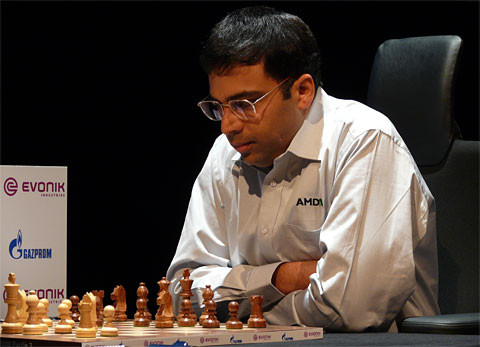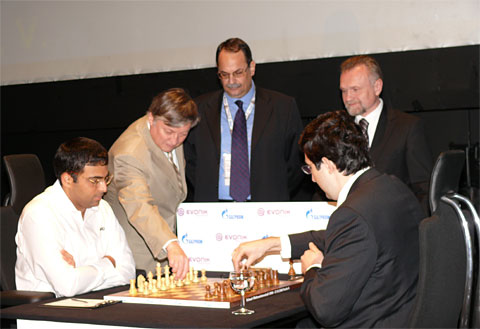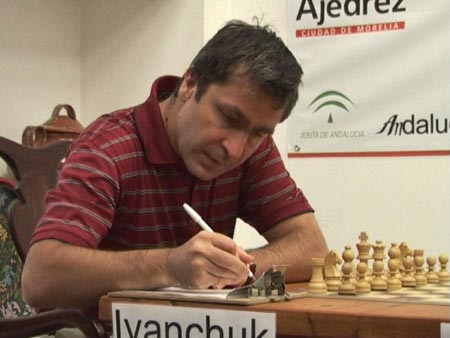| Latest | Greatest | Lobby | Journals | Search | Options | Help | Login |
|
|
|
This topic is archived. |
| Home » Discuss » Topic Forums » Sports |
|
| Jack Rabbit
|
Fri Oct-24-08 08:09 PM Original message |
| Jack Rabbit Chess Report (October 24): Vishy Just One Point from Title Defense |
|
Anand within One Point of Victory after 8 Rounds
  With the world championship match two-thirds finished, reigning champ Vishy Anand is within one point of victory over former champion Vladimir Kramnik after today's eighth round game ended in a draw in Bonn. Anand leads the match 5�-2�. Kramnik needs to score 3� points in the remaining four rounds. Almost all observers believe this is most unlikely. Anand took charge of the match by winning games five and six last week to take a three-point advantage over Kramnik. The seventh round game ended in a draw. The ninth round will be played Saturday with Anand having White. If Anand wins the game, the match ends. Sverdlovsk and Monte Carlo win European Club Cup  The European Club Cup ended in victory for the team from Sverdlovsk in the general cmpetition and for Monte Carlo in the ladies event when play finished Thursday in Kallithea on the Isthmus of Corinth in Greece. Sverdlovsk entered the seventh and final match 10 points needing a win over Saransk, another Russian team, to overtake Baden-Baden from Germany, who entered the round with 11 points and could have locked up first prize with in win over Sarajevo. Sverdlovsk defeated Saransk, 4�-1� while Baden-Baden could only manage a 3-3 draw against Sarajevo, giving each team 12 match points. However, in individual games Sverdlovsk held a 32-27� point advantage over Baden-Baden to take the title. It is important to note that Vladimir Malakhov scored a perfect 7 points for Sverdlovsk to lead the team and all players in Kallithea, and that Malakhov, Alexei Shirov and Alexander Grischuk scored wins for Sverdlovsk in the crucial last round. Monte Carlo scored 12 points to win the women's competition and was assured of a tie with Podgorica from Montenegro and the Russian team Saratov going into the last round. Monte Carlo played to a 2-2 draw against Podgorica in the last round while Saratov drew with EPAM from Belarus. Podgorica, Saratov and another Russian team, Spartak Vidnoe, each finished with 10 points. Spartak Vidnoe led the tournament in indiviual points with 19�, a half-point better than Monte Carlo and Podgorica. Monte Carlo's leading scorer was Nana Dzignide of Georgia with 6 points out of 7, who tied with Romania's Alina Motoc of Cotnari-Politehnica for the overall top score among the women. Calendar Russian Championship Playoff, Moscow Tuesday, 28 October. Svidler, Alekseev and Jakovenko in a three-sided rapid match to determine the Russian national title. Cap d'Agde Rapid Tournament 28-31 October. Pan-American Championship, Boca Raton, Florida 1-7 November. Chess Olympiad, Dresden 12-25 November. Topalov-Kamsky World Championship Semifinal Match, Lvov 26 November-15 December. Eight Rounds. Winner will challenge Anand or Kramnik in 2009. FIDE Grand Prix, Doha 13-29 December. Hasting Chess Tournament 28 December 2008-5 January 2009. Rilton Cup, Stockholm 28 December 2008-5 January 2009. Corus Chess Tournament, Wijk aan Zee 16 January-1 February 2009. |
| Printer Friendly | Permalink | | Top |
| Jack Rabbit
|
Fri Oct-24-08 08:11 PM Response to Original message |
| 1. World Championship Match, Bonn |
|
Your humble hare acknowledges the assistance of Fritz 6.0 on analysis. Diagrams on the Jack Rabbit Chess Report are made with Chess M�rida, a true type font that can be downlaoded free here. !""""""""# $tMvWlVmT% $OoOoOoOo% $ + + + +% $+ + + + % $ + + + +% $+ + + + % $pPpPpPpP% $RnBqKbNr% /(((((((() WHITE White to move (This position is a theoretical draw) |
| Printer Friendly | Permalink | | Top |
| Jack Rabbit
|
Fri Oct-24-08 08:12 PM Response to Reply #1 |
| 2. Kramnik 0-1 Anand, Round 5 |
|
Edited on Fri Oct-24-08 08:15 PM by Jack Rabbit
 Vishy Anand Vladimir Kramnik - Vishy Anand Match for the World Title, Round 5 Bonn, 20 October 2008 Semi-Slav Queen's Gambit: Meran Defense (Reynolds Opening) 1.d4 d5 2.c4 c6 3.Nf3 Nf6 4.Nc3 e6 5.e3 Nbd7 6.Bd3 dxc4 7.Bxc4 b5 8.Bd3 a6 9.e4 c5 10.e5 cxd4 11.Nxb5 axb5 12.exf6 gxf6 13.0-0 Qb6 14.Qe2 Bb7 15.Bxb5
15...Rg8!?
16.Bf4
16...Bd6 17.Bg3!?
17...f5!?
18.Rfc1 f4 19.Bh4 Be7?!
20.a4!
20...Bxh4 21.Nxh4 Ke7 22.Ra3
22...Rac8 23.Rxc8!?
23...Rxc8 24.Ra1
24...Qc5 25.Qg4 Qe5
26.Nf3 Qf6
27.Re1 Rc5 28.b4
28...Rc3!?
!""""""""# $ + + + +% $+v+mLo+o% $ + +oW +% $+v+ + + % $pP O Oq+% $+ T +n+ % $ + + PpP% $+ + R K % /(((((((() WHITE: Vladimir Kramnik Position after 28...Rc5c3 29.Nxd4?
29...Qxd4 30.Rd1 Nf6!
31.Rxd4
31...Nxg4 32.Rd7+ Kf6 33.Rxb7
33...Rc1+ 34.Bf1 !""""""""# $ + + + +% $+r+ +o+o% $ + +oL +% $+ + + + % $pP + O +% $+ + M + % $ + + PpP% $+ T +bK % /(((((((() WHITE: Vladimir Kramnik Position after 34.Bc4f1 34...Ne3!!
35.fxe3 fxe3! 0-1
|
| Printer Friendly | Permalink | | Top |
| Jack Rabbit
|
Fri Oct-24-08 08:20 PM Response to Reply #1 |
| 3. Anand 1-0 Kramnik, Round 6 |
|
Edited on Fri Oct-24-08 09:02 PM by Jack Rabbit
 Former World Champion Anatoly Karpov Makes the Ceremonial First Move to Start Round Six Vishy Anand - Vladimir Kramnik Match for the World Title, Round 6 Bonn, 21 October 2008 East India Game: Nimzo-Indian Defense (Capablanca Opening/Noa Variation) 1.d4 Nf6 2.c4 e6 3.Nc3 Bb4 4.Qc2 d5 5.cxd5
5...Qxd5
6.Nf3 Qf5 7.Qb3
7...Nc6
8.Bd2
8...0-0 9.h3!?
9...b6?!
10.g4 Qa5 11.Rc1
11...Bb7 12.a3
12...Bxc3 13.Bxc3 Qd5
14.Qxd5 Nxd5 15.Bd2
15...Nf6
16.Rg1 Rac8 17.Bg2 Ne7
18.Bb4 c5 19.dxc5 Rfd8!
20.Ne5 Bxg2
21.Rxg2 bxc5?
!""""""""# $ +tT +l+% $O + MoOo% $ + +oM +% $+ O N + % $ B + +p+% $P + + +p% $ P +pPr+% $+ R K + % /(((((((() WHITE: Vishy Anand Position after 21...bc5:p 22.Rxc5!
22...Ne4 23.Rxc8!
23...Rxc8 24.Nd3
24...Nd5 25.Bd2 Rc2 26.Bc1 f5
27.Kd1 Rc8 28.f3 Nd6 29.Ke1 a5
30.e3 e5 31.gxf5
31...e4 32.fxe4 Nxe4 33.Bd2 a4
34.Nf2 Nd6
35.Rg4 Nc4
36.e4 Nf6 37.Rg3 Nxb2
38.e5 Nd5 39.f6 Kf7 40.Ne4 Nc4
41.fxg7
41...Kg8
42.Rd3 Ndb6 43.Bh6
43...Nxe5 44.Nf6+ Kf7 !""""""""# $ +t+ + +% $+ + +lPo% $ M + N B% $+ + M + % $o+ + + +% $P +r+ +p% $ + + + +% $+ + K + % /(((((((() WHITE: Vishy Anand Position after 44...Kg8f7 45.Rc3!!
45...Rxc3
46.g8Q+ Kxf6 47.Bg7+ 1-0
|
| Printer Friendly | Permalink | | Top |
| Jack Rabbit
|
Fri Oct-24-08 08:45 PM Response to Original message |
| 4. European Club Cup, Kallithea |
|
Your humble hare acknowledges the assistance of Fritz 6.0 on analysis. Diagrams on the Jack Rabbit Chess Report are made with Chess M�rida, a true type font that can be downlaoded free here. !""""""""# $tMvWlVmT% $OoOoOoOo% $ + + + +% $+ + + + % $ + + + +% $+ + + + % $pPpPpPpP% $RnBqKbNr% /(((((((() WHITE White to move (This position is a theoretical draw) |
| Printer Friendly | Permalink | | Top |
| Jack Rabbit
|
Fri Oct-24-08 08:46 PM Response to Reply #4 |
| 5. Ivanchuk - van der Werf, General Competition, Round 1 |
 Vassily Ivanchuk Vassily Ivanchuk (Saransk) - Mark van der Werf (LSG) European Team Championship. Round 1 Kallithea, 17 October 2008 Spanish Grand Royal Game: Yates Opening 1.e4 e5 2.Nf3 Nc6 3.Bb5 a6 4.Ba4 Nf6 5.0-0 Be7 6.Re1 b5 7.Bb3 d6 8.c3 0-0 9.d4
9...Bg4 10.Be3
10...exd4 11.cxd4 d5
12.e5
12...Ne4 13.Nc3
13...Nxc3
14.bxc3 Qd7
15.h3 Bh5 16.g4
16...Bg6 17.Bg5!?
17...Rad8?!
18.Qe2 Qe6?
!""""""""# $ + T Tl+% $+ O VoOo% $o+m+w+v+% $+o+oP B % $ + P +p+% $+bP +n+p% $p+ +qP +% $R + R K % /(((((((() WHITE: Vassily Ivanchuk Position after 18...Qd7e6 19.a4!
19...Bxg5
20.axb5
20...Nxd4 21.Nxd4
21...Qb6 22.Rxa6 Qc5 23.Rc6 Qe7 24.e6
24...Rfe8 25.Qe5! fxe6
26.Rxe6! 1-0
|
| Printer Friendly | Permalink | | Top |
| Jack Rabbit
|
Fri Oct-24-08 08:48 PM Response to Reply #4 |
| 6. Olarasu - T. Kosintseva, Women's Competition, Round 3 |
|
Edited on Fri Oct-24-08 08:49 PM by Jack Rabbit
 Tatiana Kosintseva Gabriela Olarasu (Radnicki Rudovci) - Tatiana Kosintseva (Spartak Vidnoe) European Team Championship (Women's Competition), Round 3 Kallithea, 19 October 2008 East India Game: Nimzo-Indian Defense (Zurich Opening) 1.d4 Nf6 2.c4 e6 3.Nc3 Bb4 4.Qc2 0-0 5.a3 Bxc3+ 6.Qxc3 d6 7.Bg5
7...Nbd7 8.e3
8...b6 9.Bd3 Bb7
10.f3 c5 11.Ne2 Rc8 12.b4
12...cxd4
13.exd4 Ba6 14.Qb3 d5 15.cxd5!?
15...Bxd3 16.Qxd3 exd5
17.0-0 h6
18.Bf4
18...Re8 19.Ng3 Nf8 20.Rfe1
20...Rxe1+ 21.Rxe1 Ne6 22.Be5 Nd7 23.Ne2
23...Rc4
24.Bf4 b5 25.Be3
25...Nb8
26.Rd1
26...Nc6 27.Qf5 Ne7!?
!""""""""# $ + W +l+% $O + MoO % $ + +m+ O% $+o+o+q+ % $ PrP + +% $P + Bp+ % $ + +n+pP% $+ +r+ K % /(((((((() WHITE: Gabriela Olarasu Position after 27...Nc6e7 28.Qd3?!
28...Qc7 29.g3
29...a6 30.Kf2 Qd7 31.Nc1
31...Qc6 32.Ne2
32...Nc8 33.Rd2
33...Nd6 34.Kg2 Qc8 35.Rd1 Rc6 36.Qb3?
!""""""""# $ +w+ +l+% $+ + +Oo % $o+tMm+ O% $+o+o+ + % $ P P + +% $Pq+ BpP % $ + +n+kP% $+ +r+ + % /(((((((() WHITE: Gabriela Olarasu Position after 36.Qd3b3 36...Nc4!
37.Bc1
37...Ng5 38.Nf4
38...Nb6 39.Bd2 Rc2 40.h4 Ne6
41.Nxe6 fxe6 42.Kg1 Qc7!
43.f4
43...Qc6 44.Qd3 Nd7 45.Qe3 Nf6 46.Rc1 Rc4
47.Rxc4?
47...bxc4!
48.f5 exf5 49.Qe5
49...Ne4 50.Bc1
!""""""""# $ + + +l+% $+ + + P % $o+w+ + P% $+ +oQo+ % $ PoPm+ P% $+ + + P % $ + + + +% $+ B + K % /(((((((() WHITE: Gabriela Olarasu Position after 50.Bd2c1 50...c3!
51.Qxf5
51...Nxg3 52.Qe5 Ne4 53.h5 Qd7 54.Kh2
54...Qg4 55.Qxd5+
55...Kh7 56.Qe5 Nd2 57.Kh1 Nf3 0-1
|
| Printer Friendly | Permalink | | Top |
| Jack Rabbit
|
Fri Oct-24-08 08:53 PM Response to Reply #4 |
| 7. Najer - Naiditsch, General Competition, Round 4 |
 Arkadij Naiditsch Evgeny Najer (Saransk) - Arkadij Naiditsch (Baden Baden) European Team Championship, Round 4 Kallithea, 20 October 2008 Open Royal Game: Classical Defense (Scotch Opening) 1.e4 e5 2.Nf3 Nc6 3.d4 exd4 4.Nxd4 Bc5 5.Be3 Qf6 6.c3 Nge7 7.Bc4
7...Ne5
8.Be2 Qg6 9.0-0 d6 10.f3
10...0-0 11.Kh1 d5 12.f4
12...Qxe4 13.b4!?
13...Bb6
14.Bg1 Bh3
15.Rf2 Bxd4 16.cxd4 Ng4?
17.Rf3!
!""""""""# $t+ + Tl+% $OoO MoOo% $ + + + +% $+ +o+ + % $ P PwPm+% $+ + +r+v% $ + +v+pP% $Rn+q+ Bk% /(((((((() WHITE: Evgeny Najer Position after 17.Rf2f3 17...Bxg2+!
18.Kxg2 Nf5 19.Qd2?
19...Nh4+!
20.Kg3
20...Qg6 21.Kxh4 Nf6 22.Re3
22...Qxg1 23.Bf3 Rae8 24.Re5
24...Ne4 25.Bxe4
25...Rxe5 26.dxe5 dxe4 27.a4
27...e3 28.Qe2 Re8 0-1
|
| Printer Friendly | Permalink | | Top |
| Jack Rabbit
|
Fri Oct-24-08 08:54 PM Response to Reply #4 |
| 8. Cramling - E. Atalik, Women's Competition, Round 6 |
|
Edited on Fri Oct-24-08 08:54 PM by Jack Rabbit
This is a sparkling game by veteran grandmaster Pia Cramling that pretty much sewed up first prize for Monte Carlo.
 Pia Cramling Pia Cramling (Monte Carlo) - Ekaterina Atalik (EPAM) European Team Championship, Round 6 Kallithea, 22 October 2008 West India Game: Indian Queen's Gambit (Exchange Opening) (Gr�nfeld Defense) 1.d4 Nf6 2.Nf3 g6 3.c4 Bg7 4.Nc3 d5 5.cxd5 Nxd5 6.Bd2!?
6...0-0 7.e4
7...Nb6 8.Be3 Bg4 9.Be2 Bxf3
10.gxf3 e6 11.h4!?
11...Nc6
12.e5 Nd5 13.h5 Nce7
14.Qd2 Nxe3?
15.fxe3!
15...Nf5
!""""""""# $t+ W Tl+% $OoO +oVo% $ + +o+o+% $+ + Pm+p% $ + P + +% $+ N Pp+ % $pP Qb+ +% $T + K +r% /(((((((() WHITE: Pia Cramling Position after 15...Ne7f5 16.hxg6!
16...hxg6 17.f4 c5
18.d5 exd5 19.Nxd5
19...Nd4
20.Nc3
20...Nf5 21.Bd3 Qd7 22.0-0-0!
22...Rfe8 23.Qf2 Qe6 24.Be4
24...Rab8 25.Nd5?
25...Rbc8?
26.Bxf5!
26...Qxf5 !""""""""# $ +t+t+l+% $+ + +oV % $ + + +o+% $+ OnPw+ % $ + + P +% $+ + P + % $pP + Q +% $+ Kr+ +r% /(((((((() WHITE: Pia Cramling Position after 26...Qe6f5:B 27.Qh4!
27...Kf8 28.Nf6 Re7
29.Qh7! 1-0
|
| Printer Friendly | Permalink | | Top |
| Jack Rabbit
|
Fri Oct-24-08 08:56 PM Response to Reply #4 |
| 9. Shirov - Fridman, General Competition, Round 7 |
 Alexei Shirov Alexei Shirov (Sverdlovsk) - Daniel Fridman (M�lheim) European Team Championship, Round 7 Kallithea, 23 October 2008 Slav Queen's Gambit: Alapin Opening 1.d4 d5 2.c4 c6 3.Nf3 Nf6 4.Nc3 dxc4 5.a4 e6 6.e3 c5
7.Bxc4 Nc6 8.0-0 Be7 9.Qe2 cxd4 10.Rd1 0-0 11.Nxd4
11...Qc7 12.b3!?
12...Ne5
13.Ncb5 Qb8 14.Ba3 Bxa3 15.Nxa3
15...b6
16.Rac1 Bb7 17.Ba6!?
17...Rc8
18.Bxb7 Qxb7 19.f4
19...Ned7?!
20.Nc4!
20...Qa6?
!""""""""# $t+t+ +l+% $O +m+oOo% $wO +oM +% $+ + + + % $p+nN P +% $+p+ P + % $ + +q+pP% $+ Rr+ K % /(((((((() WHITE: Alexei Shirov Position after 20...Qb7a6 21.Qf3!
21...Nc5 22.Nd6 Rf8
23.b4 Ncd7 24.b5 Qxa4 25.Ra1 1-0
|
| Printer Friendly | Permalink | | Top |
| Jack Rabbit
|
Sun Oct-26-08 02:55 PM Response to Original message |
| 10. Update (Sunday): Anand and Kramnik draw; Vishy needs only to avoid loss |
|
Defending world champion Vishy Anand and challenger and former champion Vladimir Kramnik played to a 45-move draw in the ninth round of their scheduled 12-game world title match in Bonn today.
Anand, with victories in games 3, 5 and 6, leads the match by a 6-3 score. In order to draw the match and force rapid tiebreaks, Kramnik must win all three remaining scheduled game. Round 10 will be played tomorrow with Kramnik playing White. The match ends if Anand avoids loss in tomorrow's game. |
| Printer Friendly | Permalink | | Top |
| Jack Rabbit
|
Mon Oct-27-08 12:14 PM Response to Original message |
| 11. Update (Monday): Kramnik wins game 10 |
|
Challenger and former world champion Vladimir Kramnik defeated reigning champion Vishy Anand in the tenth game of their scheduled 12-game match in Bonn today.
Anand, playing Black, resigned on the 29th move with Kramnik's heavy pieces poised to bring havoc into the heart of Anand's home camp. The victory, Kramnik's first of the match, may be too little, too late as Anand leads, 6-4, and needs only to avoid loss in either of the remaining two games to retain his title. The next game, in which Anand will have White, will be played Wednesday. |
| Printer Friendly | Permalink | | Top |
| Jack Rabbit
|
Tue Oct-28-08 12:12 PM Response to Original message |
| 12. Update (Tuesday): Svidler wins Russian Championship for 5th time |
|
Grandmaster Peter Svidler of St. Petersburg won the Russian national championship today by defeating former champion Evgeny Alekseev and rising star Dmitry Jakovenko in a six round rapid playoff in Moscow.
The trio of grandmasters were tied for first place after the regularly scheduled 11-round "Superfinal" held earlier this month in Moscow with 7 points each. Svidler, 32, previously won the Russian national championship in 1994, 1995, 1997 and 2003. He follows cricket, is a fan of Bob Dylan and speaks excellent English. |
| Printer Friendly | Permalink | | Top |
| Jack Rabbit
|
Wed Oct-29-08 12:14 PM Response to Original message |
| 13. Update (Wednesday): Vishy Retains Title as 11th Game Ends in Draw |
|
World champion Vishy Anand and his challenger, former world champion Vladimir Kramnik, agreed to a draw moments ago in the eleventh game of their title match in Bonn, ending the match in 6�-4� victory for Anand.
Anand won the title a year ago in an elite tournament in Mexico City. This was his first title defense. Anand will defend his title some time next year against the winner of a match between former FIDE champion Veselin Topalov of Bulgaria and Russo-American grandmaster Gata Kamsky to be held in Lvov, Ukraine, starting November 26. |
| Printer Friendly | Permalink | | Top |
| DU
AdBot (1000+ posts) |
Wed May 08th 2024, 02:09 PM Response to Original message |
| Advertisements [?] |
| Top |
| Home » Discuss » Topic Forums » Sports |
|
Powered by DCForum+ Version 1.1 Copyright 1997-2002 DCScripts.com
Software has been extensively modified by the DU administrators
Important Notices: By participating on this discussion board, visitors agree to abide by the rules outlined on our Rules page. Messages posted on the Democratic Underground Discussion Forums are the opinions of the individuals who post them, and do not necessarily represent the opinions of Democratic Underground, LLC.
Home | Discussion Forums | Journals | Store | Donate
About DU | Contact Us | Privacy Policy
Got a message for Democratic Underground? Click here to send us a message.
© 2001 - 2011 Democratic Underground, LLC